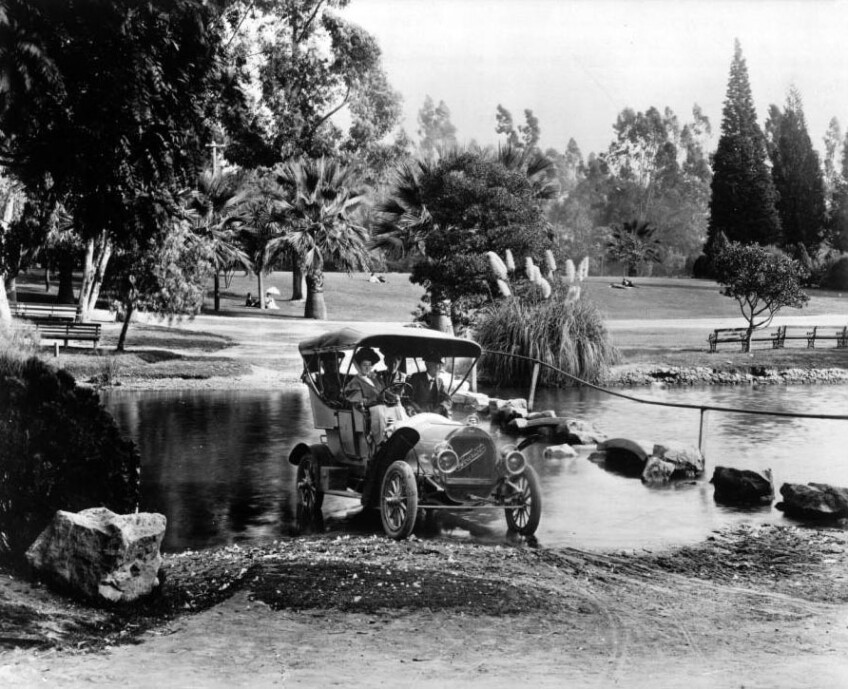When Lincoln Park Was Eastlake

The second in a series -- introduced here -- looking at the origins of Los Angeles' oldest parks.
Like many of Los Angeles' first public parks, Eastlake (now Lincoln) Park began as unwanted land: a fifty-acre site rejected by a railroad and given to the city for free. But like its crosstown rival, Westlake (now MacArthur) Park, Eastlake soon grew into one of the city's most popular outdoor retreats.
Located along an old wagon road to the San Gabriel Mission, the land that eventually became Lincoln Park might never have become a public space were it not for the Southern Pacific Railroad. The corporation had acquired the land as a site for its maintenance shops in 1874, transferred by the city of Los Angeles to the railroad as a sort of ransom. (The railroad was then extending its transcontinental line to Southern California and had threatened to bypass Los Angeles if the city did not pay $610,000 in fees and in-kind contributions, including land for its rail shops.)
But the railroad never located its facilities there. Perhaps it thought the land unsuitable; the bed of one of L.A.'s lost streams, the Arroyo de las Pasas, crossed the site on its path from the Monterey Hills to the Los Angeles River, rendering the ground marshy in places.
As the years passed, though, residents of the budding suburb of East Los Angeles began clamoring for a public park, and city leaders looked to the railroad's unwanted land as a potential site. In 1881, the city demanded that the railroad either build its shops or return the land. Viewing it as worthless, the Southern Pacific deeded the site back to the city.
City property once again, the fifty acres continued to sit unused -- marked on maps as a "City Park" but virtually unchanged from its primitive condition.
A city nursery finally appeared there in 1886, but the site still lacked the basic features of a city park like strolling paths, landscaping, and benches. Anxious residents of East Los Angeles complained to the city council that the park land was being neglected. The city would improve the site "in due time," the council replied. It eventually took the personal intervention of Mayor Henry Hazard several years later to spur the site's conversion into a public pleasure ground: East Los Angeles Park.

Improvements began in 1889, lasting three years and costing nearly $15,000. The existing nursery and greenhouse were kept as attractions. Workers added graveled drives and walking paths through the park, planted trees and flowers, and sodded lawns. By April 1892, the landscaping was nearly complete.
"The park is rapidly assuming the appearance of the garden-like resort it is intended to be," the Los Angeles Times reported. "A stroll through the grounds can now be made with real pleasure, the walks and drives having been put in good condition and covered with gravel. The new hothouse and conservatories were completed some time ago and are now well filled with young plants and rare exotics, well worthy of inspection by lovers of the botanical sciences."
The project's biggest component -- and still the park's most scenic feature -- was a large artificial lake built in the bed of the arroyo. Workers created it by erecting a dam along present-day Valley Boulevard, flooding eight acres of the streambed, and then adding accents like a footbridge and water lilies.
Connected to the city by two streetcar lines, Eastlake Park drew big and enthusiastic crowds, which only swelled in size after the city added a boathouse and band shell in the late 1890s. Animals at the first city zoo entertained children, and on Sundays, up to 12,000 Angelenos flocked to the park for open-air concerts.
By 1903, Eastlake had become the crown jewel of the city's park system.
"Sitting on the grassy banks of Eastlake and gazing about," Belle Sumner Angier wrote for the Times in 1903, "it seems almost incredible that less than fourteen years ago this was a barren hill, with but one shrub on the fifty-six acres."
By the time local residents rechristened it Lincoln Park in 1917 (the name of the surrounding neighborhood changed, too, from East Los Angeles to Lincoln Heights), the park an its environs had begun to resemble a prototypical theme park. Privately owned tourist attractions -- including an alligator farm, ostrich farm, the Selig (Luna Park) Zoo, a hot sulphur bathworks, and an Indian village -- clustered around the public park grounds, drawing tourists and local residents alike to the once-neglected land.











Many of the archives who contributed the above images are members of L.A. as Subject, an association of more than 230 libraries, museums, official archives, cultural institutions, and private collectors. Hosted by the USC Libraries, L.A. as Subject is dedicated to preserving and telling the sometimes-hidden stories and histories of the Los Angeles region. Our posts here provide a view into the archives of individuals and institutions whose collections inform the great narrative—in all its complex facets—of Southern California.